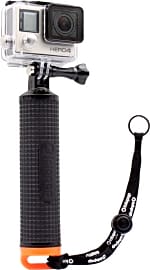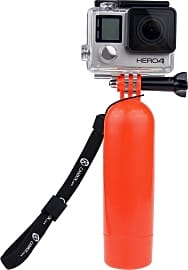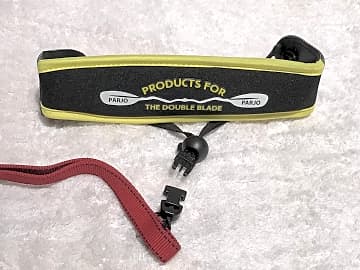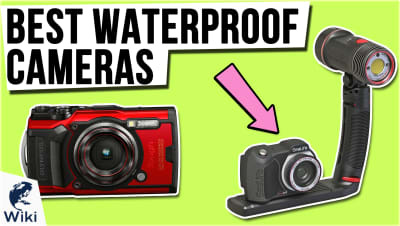The 8 Best Floating Cam Straps

This wiki has been updated 37 times since it was first published in April of 2016. Picture the scene: you're leaning over the railings of the "Maid of the Mist" boat about to get an awesome up-close shot of Niagara Falls when ... you drop your action camera into the water and watch it slowly sink to the murky depths. AAARRRGGGHHH! Make sure this never happens to you by attaching your device to one of these floating cam straps when out snorkeling, boating, or kayaking. When users buy our independently chosen editorial choices, we may earn commissions to help fund the Wiki.
Editor's Notes
April 21, 2020:
There is nothing worse than losing a camera while snorkeling or enjoying some other water-based activity. Not only are you probably looking at a costly replacement, but you'll also never get a chance to enjoy those irreplaceable photos and videos you were recording. While we can't guarantee that will never happen with one of these floating cam straps, the chances are significantly reduced.
Since floaters offer different levels of buoyancy, you'll want to consider the weight of your action cam before picking one out. If you have a heavier camera or phone you are trying to keep afloat, you'll need to choose a model with a lot of buoyancy, such as the JJC ST-8R, Catalyst Lanyard, Lotopop Hand Grip, AmazonBasics GP-FLP-03, and CamKix LUDSW. All of these can safely float devices weighing as much as 11 ounces up to the surface, and some even heavier ones.
When it comes to versatility, the CamKix 2-in-1 and Lotopop Hand Grip stand apart from the rest of the pack. The former doubles as a headstrap float, while the latter has a dry storage compartment that you can fill up with water if you want to make it neutrally buoyant for use while diving. This way you wont have to try and chase your camera to the surface if it slips out of your hand, which presents its own dangers, such as a risk of not properly decompressing. The AmazonBasics GP-FLP-03 should also be mentioned for its addition of a carabiner, which you can use to attach it to a BCD or life jacket when you want your hands free for other purposes.
The Nordic Flash Pack and JJC ST-8R are simple, low-priced options that work well enough for their intended purposes. Of these, we like the JJC ST-8R better since it includes a snap band you can use to tighten it on your wrist.
Special Honors
How to Clean Your GoPro Camera It is important that you properly care for your camera after any underwater outing, but especially so when using it in the ocean. This helpful guide from GoPro has some great tips on maintaining your device after using it in the water, so it continues to function properly for years to come. community.gopro.com
Proper Care and Maintenance of the Nikon Coolpix While this guide is intended for owners of the Nikon Coolpix series of underwater cameras, most of the information applies to those from other manufacturers as well. It covers tips like checking to make the sure any gaskets are not cracked or deformed before submersion and how to clean the device after saltwater use. nikonusa.com
Don't Lose Touch
Instead, it will float calmly on the surface for you to retrieve at your leisure.
Water makes things slippery. There is no denying this. If not, we wouldn't bother to put up those familiar yellow caution signs when a floor is wet in commercial areas. When it comes to digital cameras and action cameras, its not slipping we are worried about, but rather losing our grip, specifically when swimming or engaged in some other marine activity where a dropped camera results in it plummeting to murky depths, never to be seen again.
Dropping a camera in the water is, unfortunately, quite a common occurrence. We are not perfect creatures. If we were, we wouldn't have need of cameras in the first place, since we would have photographic memories and could just close our eyes to relieve that special moment. More often than not, we pull out a camera to capture a thrilling or beautiful moment that we want to be able to share with friends and family, or perhaps post on Facebook for the world to see. These are also the moments when we are most likely to drop said camera, since we may be distracted, excited, or just plain captivated.
Anybody who has kids knows they often like to get involved in the action. Most kids want a chance to try their hand at photography, just like you do. But, If you are anything like most parents, you loathe handing your child an expensive device, like a camera, in a situation where they could easily lose it. Of course, you don't want to show your child you don't have faith in their abilities to take care of important items, either.
Enter the floating camera strap to save the day. A floating camera strap ensures that even if you or your child drops your camera, whether from a boat into the water or while snorkeling, it won't be lost forever. Instead, it will float calmly on the surface for you to retrieve at your leisure.
The Two Main Types Of Floating Camera Straps
Floating camera straps generally come in two main forms, handheld varieties and those that wrap around your wrist. Each form has its own pros and cons, so depending on how you plan to use your camera, during which activities, and what type of camera you have, one or the other might be your best choice.
Their pliable form means that you can easily shove them into practically any bag.
The most defining feature of the handheld floating camera strap, other than the fact that they float of course, is they provide you with a secure way to grip your action camera while performing a range of activities. It is well-known that action cameras are small. They have to be since most people use them while involved in extreme sports, where a large camera would be cumbersome and impractical. Unfortunately, this small form often results in a less-than-secure grip.
For all intents and purposes, floating handheld camera straps are basically small buoys. They are air-filled chambers that feature some type of camera mount. Most are somewhere between five and seven inches long, which provides you with plenty of space to wrap your hand around them comfortably. Many double as storage devices where you can stash some cash or a pair of keys. Some have a textured grip on the buoy, which is a smart feature to look out for. Pretty much every handheld model will also come with a wrist strap as an extra security measure to further reduce the possibility of losing your camera. It is rare to find a handheld model that attaches to a traditional waterproof digital camera, since they generally use the Go-Pro style thumbscrew mount as an attachment point. For this reason, handheld models are best for those who use action cameras to record their underwater escapades.
Floating wrist straps are nice as they hardly take up any storage space. Their pliable form means that you can easily shove them into practically any bag. Since they don't require you to hold onto them, they free up your hands for other uses, such as adjusting your mask or holding onto a child. Nice features to have in floating wrist straps are clips that allow for quick camera detachment and adjustable sizing to reduce the chances of it sliding off your wrist.
Tips For Great Underwater Photography
Learning how to take great underwater photographs is a skill that requires dedication and practice. Luckily, there are a few simple tips that can greatly enhance the quality of your shots, even if you aren't an experienced photographer. Ideally, you want to get as close to your subject matter as possible. Of course, this may not be feasible for very fast moving or dangerous animals, such as a shark or manta ray. If shooting small marine life, like crustaceans or sea anemone, try to bring your camera within 12 inches of the subject. Water will reduce contrast, sharpness, and color, so the closer you are, the better. Any time you are taking photos of subjects less than four feet away, you should have the flash set to on. This means setting it to forced flash, not auto flash. Leaving the flash off will result in underexposed subjects with a bluish tinge.
If you are taking photos of subjects from farther away, it may be best to use natural light.
If you are taking photos of subjects from farther away, it may be best to use natural light. This is because using the flash on objects that are far away often results in backscatter, unless you are in exceptionally clear water. Using natural light is only suitable when you are in less than 20 feet of water, however. Any deeper and the sun's rays won't be able to create enough ambient light for high quality shots. If using natural light, make sure the sun is behind you.
If taking photos of human subjects, it is best to do so within five feet of the surface. As you go deeper, you begin to lose the warm red and orange hues in the skin, resulting in the subject looking looking less vibrant. When it comes to composition, it is best to shoot at an upwards angle when underwater. It also helps to fill the entire frame with your subject, rather than to try and follow the rule of thirds and position them off to one side.













